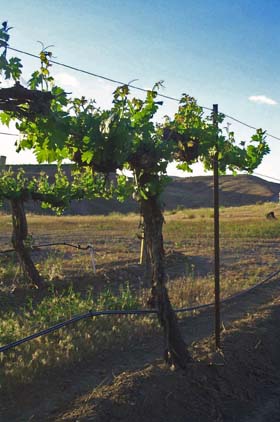 |
||||||||||||
|
The Soil Survey of Yakima County Area, Washington (Lenfesty and Reedy, 1985) describes the Warden series soil as follows: “This very deep, well drained soil is on terraces. It formed in lacustrine sediment and has a mantle of loess. The native vegetation is mainly grasses, forbs, and shrubs. Elevation is 600 to 1,000 feet. The average annual precipitation is 6 to 9 inches, the average annual air temperature is about 51 degrees F, and the average frost-free season is 135 to 180 days.” “Typically, the surface layer is brown silt loam about 5 inches thick. The subsoil is pale brown silt loam about 14 inches thick. The substratum to a depth of 60 inches or more is light gray and pale brown, stratified silt loam, and very fine sandy loam. In some areas the surface layer is fine sandy loam.” The Harwood-Burke-Wiehl series silt loams, 2 to 60 percent slopes occur, in a landscape complex of these three distinctive, different soils, on ridge tops sideslopes of steeper hills underlain by old alluvium and soft sediments of the Ellensburg Formation – places most conducive for grape plantings. This complex of soils, which is formed from loess that overlies remnants of the Ellensburg Formation, is common in the Rattlesnake Hills but is found only is isolated places elsewhere in the Yakima Valley. The Harwood series soils are stony and less than 30” to a lime-silica cemented hardpan; The Wiehl series soils are only about 27 inches deep on average to soft sandstone, and the Burke series soils are about 25” deep to a hardpan. These soils are shallow and produce or exacerbate water deficit stress compared to deeper soils in other areas, and controlled water stress (also called deficit irrigation) is positively correlated with grape and wine quality when judiciously applied. Therefore, they contrast strongly with the deep, uniform silt loam-textured and sandier soils that characterize the majority of planted acres in the remaining parts of the Yakima Valley AVA. The Soil Survey of Yakima County Area, Washington (Lenfesty and Reedy, 1985) describes this soil complex as follows: “This map unit is on uplands. The native vegetation is grasses, forbs, and shrubs. Elevation is 1,000 to 1,300 feet. The average annual precipitation is 6 to 10 inches, the average annual air temperature is about 50 degrees F, and the average frost-free season is 135 to 170 days.” “This unit is about 30 percent Harwood silt loam, about 30 percent Burke silt loam, and about 20 percent Wiehl silt loam. The components of this unit are so intricately intermingled that it was not practical to map them separately on the scale used.” Along the top of Rattlesnake Ridge are areas of Lickskillet series silt loam and Starbuck series silt loam with areas of a Starbuck-Rock outcrop complex. Some of these areas are planted to wine grapes where water is available. The Soil Survey of Yakima County Area, Washington (Lenfesty and Reedy, 1985) states: “Lickskillet silt loam, 5-30 percent slopes: This shallow, well drained soil is on uplands. It formed in loess and in residuum and colluvium derived from basalt. Most slopes are about 10 percent. The native vegetation is mainly grasses, forbs, and shrubs. Elevation is 1,500 to 3,200 feet. The average annual precipitation is 10 to 20 inches, the average annual air temperature is about 48 degrees F, and the average frost-free season is 120 to 150 days.” Webmaster Rattlesnake Wine © 2024 All rights reserved
|
|||||||||||

 The primary soils suitable for
Yakima Valley in the Rattlesnake Hills are the Warden series silt loams, 0 to 30% slopes, and a landscape complex of the
Harwood-Burke-Wiehl series silt
loams, 2 to 60 percent slopes.
The primary soils suitable for
Yakima Valley in the Rattlesnake Hills are the Warden series silt loams, 0 to 30% slopes, and a landscape complex of the
Harwood-Burke-Wiehl series silt
loams, 2 to 60 percent slopes.